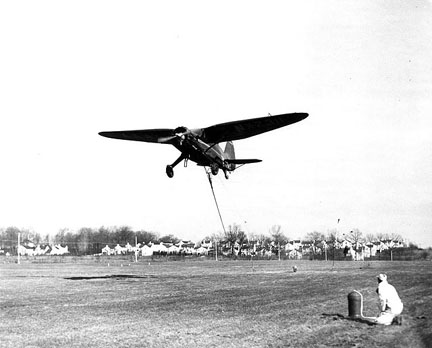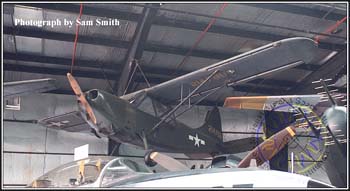|
 aircraft database
aircraft database
 certified aircraft database
certified aircraft database

 history and gallery
history and gallery
 SR-10 Reliant
SR-10 Reliant
 Station Wagon 108-3
Station Wagon 108-3
 L 5 Sentinel
L 5 Sentinel
 Model 105 Voyager
Model 105 Voyager
 L-5 Sentinel flight test report
L-5 Sentinel flight test report
|
|

Stinson Aircraft Corporation aircraft history, performance and specifications
|
 |


The
Stinson SR-10F Reliant was one of a series
of powerful cabin airplanes outfitted as
executive and business aircraft or as
sturdy utility aircraft and airliners.
The SR-10 series was produced until the
beginning of World War II.
The
Stinson Aircraft Company was founded in
Dayton, Ohio, in 1920 by aviator Edward
“Eddie” Stinson—nine years after he learned
to fly with the Wright Brothers. In 1925
Stinson would make Detroit, Michigan, the
base of operations for his company. Over the
next three decades, more than 13,000
aircraft would carry the Stinson brand.
Born
in 1894 in Ft. Payne, Alabama, Eddie Stinson
left school at age 16 and set out for St.
Louis, Missouri, with a mission—to pilot an
untested aircraft being built by a pair of
men he did not know. Bursting with youthful
bravado, Stinson convinced the fledgling
aircraft builders that they lacked any
practical flight experience and persuaded
them to hire him as their pilot—conveniently
forgetting to mention that he had never even
seen an airplane before, much less flown
one.
The
flight test program was unremarkable. With
Eddie Stinson at the controls, the kite-like
aircraft briefly wobbled skyward from a farm
pasture in a puff of blue smoke; then
crashed back to earth, losing a wing in the
process. The would-be aircraft builders gave
Stinson the mangled aircraft as payment and
moved on to other ventures; for Stinson, it
was the start of a lifelong vocation.
Realizing that his brief experience as a
“test pilot” did not qualify him as an ace
flyer, Stinson exchanged his life savings of
$500 in 1911 for flight instruction at the
Wright Brothers' Dayton flight school. After
graduation, Eddie Stinson quickly earned
acclaim as a barnstormer, stunt pilot, and
record-setting aviator.
Stinson sisters Katherine and Marjorie were
also skilled pilots and aviation pioneers in
their own right. Katherine sold the family's
piano to pay for her flying lessons,
becoming in 1912 only the fourth woman in
the United States to earn a pilot's license.
At age 21 and weighing a diminutive 101
pounds, she became widely known as the
“Flying Schoolgirl,” performing in air
exhibitions in the United States and
overseas and becoming the first woman pilot
authorized by the Post Office to fly
airmail. Younger sister Marjorie also
learned to fly at the Wright School,
becoming the ninth and youngest American
woman to earn pilot's wings and later, she
was also commissioned as an airmail pilot.
Settling in San Antonio, Texas, in 1915, the
Stinsons established the Stinson School for
Aviation. After the United States' entry
into World War I, the Stinson family trained
U.S. Army and Canadian pilots at San
Antonio's Kelly Field, earning Eddie an Army
lieutenant's commission while Marjorie
acquired the nickname of “The Flying
Schoolmarm.”
In
1920, Eddie Stinson purchased the Dixie
Flying Field in Birmingham, Alabama, with
the intention of establishing a new flight
school but instead, he soon relocated to
Dayton where he formed the Stinson Airplane
Company that same year. After five years of
various business ventures, Stinson decided
that Detroit would be the focus for his
future flying endeavours.
Stinson found Detroit's business community
receptive to his plans. A group of local
businessmen—the Detroit Board of Commerce's
Aviation Committee—supported Stinson's plans
to establish the Stinson Aircraft Syndicate
in 1925 at a site southwest of Detroit,
where today's Detroit Metropolitan Airport
is located, and provided $25,000 to develop
a new monoplane.

Stinson
SM-1 Detroiter
The
six-seat Stinson SM-1 Detroiter made its
first flight on January 25, 1926—the first
airplane with a heated, soundproof cabin,
electric starter, and wheel brakes.
Inherently stable in flight, the Detroiter
became an overnight success that enabled
Stinson to quickly assemble $150,000 in
public capital to incorporate the Stinson
Aircraft Corporation on May 4, 1926. Always
an aviator at heart, Eddie Stinson was still
flying as a stunt pilot, earning $100,000 a
year for his efforts—a huge sum in those
days.

The Stinson SR-10F Reliant was used for
picking up the mail in 1939 by means of a
skyhook.
Stinson Aircraft Corporation sold 10 SM-1
Detroiters in 1926, and started refining the
basic design. The Stinson SM-2 Junior, a
three- or four-seat high-wing cabin
monoplane designed for both business and
personal flight, soon followed. Business
steadily increased, and Stinson delivered
121 aircraft in 1929.
Automobile mogul E.L. Cord acquired 60
percent of Stinson's stock in September
1929, and his Cord Corporation provided
additional investment capital to permit
Stinson to sell its aircraft at a
competitive price while still pursuing new
designs. At the height of the Depression in
1930, Stinson offered six aircraft models,
ranging from the four-seat Junior to the
Stinson 6000 trimotor airliner.
Eddie
Stinson did not live to enjoy the success of
his company. He died in an air crash in
Chicago on January 26, 1932, while on a
sales trip. At the time of his death at age
38, Stinson had acquired more than 16,000
hours of flight time—more than any other
pilot to date.
Two
new Stinson designs—the 1931 Model W and the
1932 Model R-2/3—were powered by Wright or
Lycoming radial engines and combined
dependable performance with a luxurious
cabin. These two models were the ancestors
of the most famous of the Stinson line—the
Reliant, first introduced in 1933.
From
1933 to 1941, Stinson delivered 1,327
Reliants—ranging from the SR-1 through the
SR-10—each variation building upon its
predecessor with upgraded engines and design
refinements. The Stinson Reliant SR-10,
introduced in 1938, was considered the
ultimate, featuring leather upholstery,
walnut instrument panels, and
automobile-style roll-down windows.
The
Stinson Reliant was a rugged aircraft built
of fabric-covered welded steel-tubing
structures with a single strut-braced
double-tapered wing, and one of the last of
the “taildraggers” (an airplane lacking a
nose-wheel so it looked like its tail
dragged when taxiing). Powered by a radial
engine, the Reliant carried a pilot plus
three or four passengers at speeds close to
165 miles per hour (266 kilometres per hour)
and could fly about 815 miles (1,312
kilometres) on a tank of fuel. Pilots
appreciated the Reliant's durability,
safety, and stability in flight, while
passengers enjoyed a comfortable ride in an
opulent cabin.
The
Reliant's high price tag—new models sold for
between $10,000 and $18,000—prevented its
wide acceptance among private fliers, but
corporations and commuter airlines eagerly
purchased the plane because of its speed,
amenities, and styling. Gulf Oil, Shell Oil,
and Pepsi Cola were among the corporations
to use Stinson Reliants to ferry their
executives and clients around the country,
while future military leaders Dwight
Eisenhower and Jimmy Doolittle used the
airplane as a versatile transport in remote
areas such as the Philippines.
Stinson Reliants also played a unique role
in the history of the United States Post
Office. In 1939, an experimental airmail
“sky hook” service was introduced in rural
communities that lacked air strips. A
container loaded with mail was positioned on
the top of a tall pole. A Stinson Reliant
swooped down as the flight officer grappled
the airmail container with a long hook while
incoming airmail was dropped from the plane
to a waiting Post Office representative.

Stinson built their first retractable gear
airplane, the Stinson model R-3, NC449M,
serial number 8600. This particular view
shows the registration without the NC, and
it may be this photo was taken prior to type
approval. Few high wing airplanes ever had
retractable landing gear, the Stinson R-3
used a mechanical system. Engine was 240HP
Lycoming R-680, Type Certificate 493.
Another popular Stinson aircraft was the
Model 105 Voyager, a three-passenger
airplane featuring a strut-braced wing
mounted on the top of the fuselage and
capable of flying at about 120 miles per
hour (193 kilometres per hour). First
introduced in 1939, Stinson sold about 530
Voyagers before World War II intervened and
the Stinson aircraft line was adapted for an
important mission.

The
105 Voyager became the U.S. Army's L-5
Sentinel. It remains one of the most used,
and least recognized, U.S. aircraft of the
Second World War. Serving as a short field
takeoff and landing liaison aircraft, the
L-5 Sentinel supported missions such as
artillery spotting, medical evacuation,
aerial reconnaissance, and passenger
transport. Stinson delivered more than 3,590
of the versatile Sentinels between 1942 and
1945 under a variety of designations. A few
pre-war Voyagers were commandeered for
wartime use and designated the AT-19/L-9.

The Stinson L-5 Sentinel was one of many
pre-World War II U.S. general aviation
aircraft pressed into military service for
liaison and observation work during World
War II
The
U.S. Navy and Marine Corps received 458
Sentinels transferred from the Army,
designating their models as the OY-1 and
OY-2, while two versions went to the British
Royal Air Force as the Sentinel Mk. I and
Sentinel Mk. II. After the war, most
Sentinels were sold for surplus, but a
number of aircraft (now designated the U-19)
served in the Korean conflict. A few
Sentinels remained in active military
service until the late 1950s.

The
Stinson SR-10 Reliant was also transformed
for use in World War II as the UC-81, used
by the U.S. Army as a utility aircraft, and
the AT-19/V-77, used by the British Royal
Navy for a passenger transport, instrument
trainer and photo-reconnaissance aircraft.
The
Stinson name did not last much past the end
of World War II. Eddie Stinson's tragic
death accelerated the assimilation of
Stinson Aircraft Corporation into larger
corporate entities: first by Cord
Corporation, then by Aviation Corporation (AVCO),
and later by Consolidated Vultee. These
corporate reorganizations, however, did not
diminish the legacy of Eddie Stinson—a high
school dropout whose dreams of flying led to
the creation of an aviation trendsetter.

|
|
